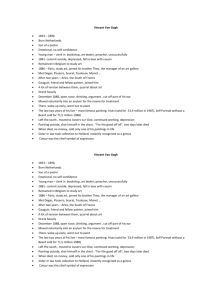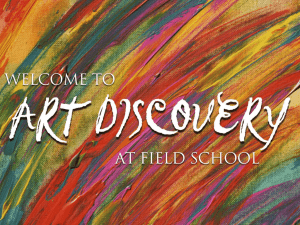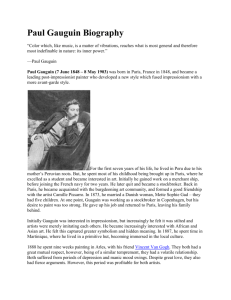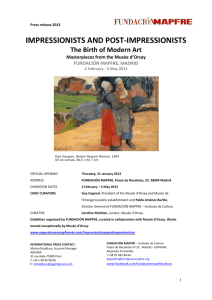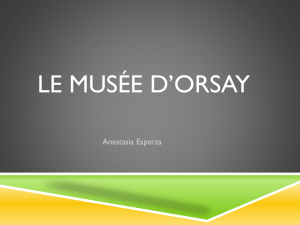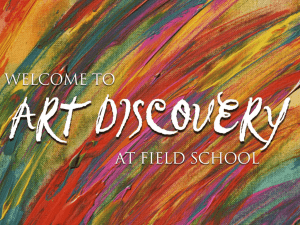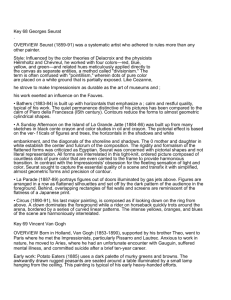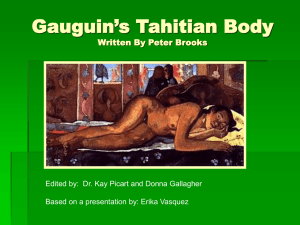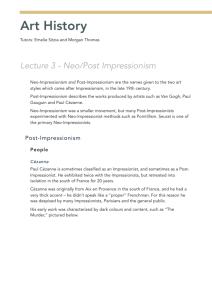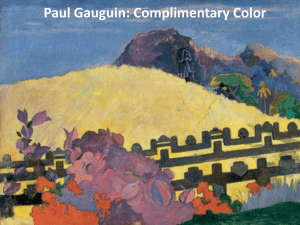The Triumph of Color: From Van Gogh to Matisse. Collections of the
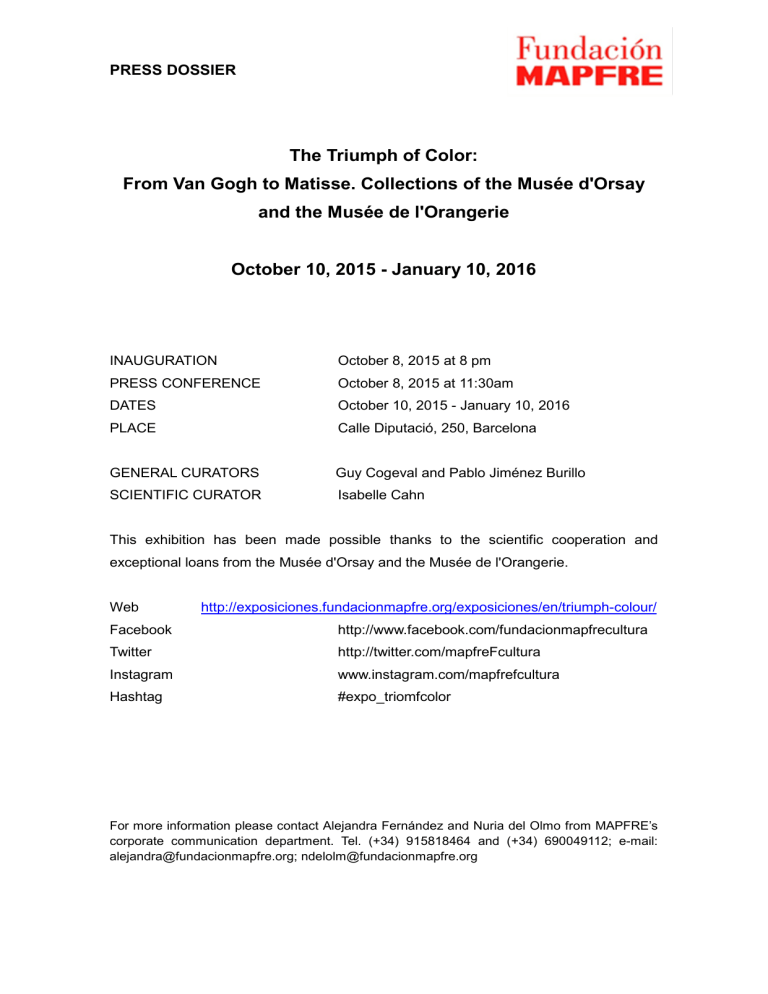
PRESS DOSSIER
The Triumph of Color:
From Van Gogh to Matisse. Collections of the Musée d'Orsay and the Musée de l'Orangerie
October 10, 2015 - January 10, 2016
INAUGURATION
PRESS CONFERENCE
DATES
PLACE
October 8, 2015 at 8 pm
October 8, 2015 at 11:30am
October 10, 2015 - January 10, 2016
Calle Diputació, 250, Barcelona
GENERAL CURATORS
SCIENTIFIC CURATOR
Guy Cogeval and Pablo Jiménez Burillo
Isabelle Cahn
This exhibition has been made possible thanks to the scientific cooperation and exceptional loans from the Musée d'Orsay and the Musée de l'Orangerie.
Web
Facebook http://exposiciones.fundacionmapfre.org/exposiciones/en/triumph-colour/ http://www.facebook.com/fundacionmapfrecultura
Twitter http://twitter.com/mapfreFcultura
Hashtag www.instagram.com/mapfrefcultura
#expo_triomfcolor
For more information please contact Alejandra Fernández and Nuria del Olmo from MAPFRE’s corporate communication department. Tel. (+34) 915818464 and (+34) 690049112; e-mail: alejandra@fundacionmapfre.org; ndelolm@fundacionmapfre.org
PRESS DOSSIER
From October 10, 2015 to January 10, 2016, FUNDACIÓN MAPFRE exhibition center
(Calle Diputació, 250, Barcelona) will be hosting The Triumph of Color: From Van Gogh to Matisse. Collections of the Musée d'Orsay and the Musée de l'Orangerie.
The exhibition, organized especially for the Barcelona venue, takes a look at how color becomes a means of transition from Impressionism to avant-garde painting through a selection of over 70 works by some of the greatest artists of the period.
The 19th century is characterized by the progressive, unstoppable domination of color over drawing as the predominant genre in art. Back in the 1850s, Charles Baudelaire noted in his diaries: “I should like the fields tinged with red, the rivers yellow and the trees painted blue”. Color would gradually spill over the lines, spreading and filling up the entire picture surface. Following Impressionism, color explodes and sensation, the subjective experience, the personal vision of the artist becomes paramount; the artists sense that color expresses something in itself and set out to discover it; as expressed in their own correspondence and diaries, they gradually move away from the natural model and closer to the abstraction of color.
The origin of the term Post-Impressionism can be traced to 1910, when the Grafton
Gallery opened its doors with the exhibition Manet and the Post-Impressionists .
Organized by the British critic Roger Fry, the exhibition was dedicated to 19th century
French painting and mainly featured works by Cézanne, Gauguin and Van Gogh. It was a difficult time that brought together experiences as personal as those of Cézanne, Van
Gogh, Odilon Redon and Toulouse-Lautrec, as well as offshoots of Impressionism and other movements that emerged as a reaction to it.
The confluence of a carefully-selected group of works by masters like Van Gogh,
Gauguin, Seurat, Signac, Bonnard, Vuillard, Cezánne, Derain and Matisse and paintings by lesser-known artists such as Charles Angrand, Georges Lemmen and
Félix Valloton, make this exhibition a unique opportunity to explore this period of intense creativity.
The show has been organized by FUNDACIÓN MAPFRE with the scientific cooperation and exceptional loans from the Musée d'Orsay and the Musée de l'Orangerie. It is curated by Guy Cogeval, president of these two French institutions,
PRESS DOSSIER and Pablo Jiménez Burillo, director of the FUNDACIÓN MAPFRE’s Culture Department, with the help of Isabelle Cahn, curator of the Musée d'Orsay.
The exhibition will be accompanied by a catalog available in Spanish and Catalan.
Layout of the exhibition
The exhibition is divided into four sections:
Scientific color presents a selection of works based on research carried out by the chemist Michel-Eugène Chevreul, which served as the foundation for the development of neo-Impressionist technique. This technique consisted of painting juxtaposed dots of primary or complementary colors on the canvas so they appear more vibrant, mixed together by the viewer’s eye.
Related to the trip Gauguin would take to Brittany and his 1888 meeting with Émile
Bernard, the section The Mysterious Center of Thought: Gauguin and the Pont-Aven
School contains a series of works that reflect the experiments carried out by both of these artists, who developed a new, synthetic style of painting marked by the presence of dark contours and the use of flat planes of symbolic, arbitrary color.
The Talisman, a little panel painted in Pont-Aven in 1888 by Sérusier under the supervision of Gauguin, opens the third section: The Nabis: Prophets of a New Art.
This work reflects the aesthetic ideology of this group of artists who would lead the avant-garde movement of 19 th
century Paris and defend the spiritual origin of art using color to convey moods.
Color in Liberty brings us to Matisse. In the early 20th century, Young painters seemed to be suffering from an epidemic expressed in lines of pure color: rounded or more square, close together or spaced far apart, scratches. In the words of Paul Signac, “it is the love of the beauty of color” that impels them to use pure, vivid hues.
Scientific Color
1886 was the year of the eighth and final Impressionist exhibition, marking the turning point between the end of Impressionism and the emergence of what has come to be
PRESS DOSSIER known as Post-Impressionism. It was undoubtedly a date in the lives of the main figures of the period: it brought the death of Cézanne’s father, allowing the artist to feel completely free to focus on his painting, becoming the fundamental link between the two movements; Van Gogh’s trip to Paris, where he would live with his brother Theo and meet Toulouse-Lautrec, Louis Anquetin and Émile Bernard; and Gauguin’s retirement to Pont-Aven, a decisive event that would trigger the birth of Synthetism.
Vincent Van Gogh
Portrait de l'artiste, otoño, 1887
[Autorretrato]
Óleo sobre lienzo, 44 x 35,5 cm
Musée d´Orsay, París
Donación de Jacques Laroche en 1946
RF 1947 28
Photo © Musée d'Orsay, Dist. RMN-Grand
Palais / Patrice Schmidt
The chemist Chevreul’s research on color contrasts, which was translated and spread around the world in the 1860s, became a work of reference among painters. It also served as the theoretical foundation for many experiments with color by artists in last few decades of the 19th century, especially by the members of what Félix Feneón dubbed the “Neo-Impressionist” movement, led by Seurat.
The Pointillism technique devised by Seurat consists of juxtaposing dots of color, primary or complementary to make them appear as solid, more vibrant forms; rather than being blended on the palette, colors are combined in the viewer’s retina. To quote
Signac, a theoretician and advocate of the movement upon Seurat’s premature death:
“The Neo-Impressionist painters are the artists who established and, after 1886, developed the technique called divisionism by using as their mode of expression the optical mixture of tones and hues.”
Van Gogh himself, who was familiar with these Neo-Impressionist experiments, would trade the dark palette of his early period for bright colors, though he refused to be conditioned by any kind of scientific framework. For him, “color expresses something by itself” and was charged with emotion.
PRESS DOSSIER
Seurat’s work would soon earn the appreciation of his contemporaries as well as important followers such as Signac and even Pissarro, a founding member of the
Impressionist movement who adopted Seurat’s particular style of brushwork in his paintings, as we can see in Jeune paysanne faisant du feu. Gelée blanche . [Peasant
Girl Lighting a Fire. Frost] This new way of painting based on carefully arranged, deliberate strokes of paint was totally opposite from the spontaneity of Impressionist brushwork. In 1887, Charles Angrand, Henri-Edmond Cross and Maximilien Luce would also join the movement.
Georges Seurat
Port-en-Bessin, avant-port, marée haute,
1888
[Port-en-Bessin, antepuerto con pleamar]
Óleo sobre lienzo, 66 x 82 cm.
Musée d´Orsay, París
Adquirido con los fondos de una donación anónima canadiense, 1952
RF 1952 1
Photo © RMN-Grand Palais (musée d'Orsay) /
Hervé Lewandowski
In the Mysterious Center of Thought: Gauguin and the Pont-Aven School
“Pure color! Everything must be sacrificed to it. Color being enigmatic in itself in the sensations it gives us, logically we cannot employ it any other way than enigmatically every time we use it, not to draw with but rather to give the musical sensations that flow from its own nature, form its internal, mysterious, enigmatic power. (…)”
Paul Gauguin
The evolution of color takes us to Pont-Aven, a small town in the French region of
Brittany, which would become, from 1860 on, a refuge for artists who wanted to flee from the city.
PRESS DOSSIER
Motivated by his artistic interests and pressing financial problems, Paul Gauguin first came to Pont-Aven in 1866, seeking a return to the primitive; to the origins of civilization and knowledge. Country scenes and landscapes dominate his work from this period, characterized by a renunciation of three-dimensionality, an anti-naturalistic use of color and pronounced contours. For Gauguin, painting reflects an inner, poetic, spiritual world: “Art is an abstraction. Extract it from nature, dreaming before it, and think more of the creation which will result than of nature.”
In 1888 he crossed paths with Émile Bernard, who was already exploring similar ideas; together, they developed a new way of painting, synthetic and essential, characterized by the use of arbitrary, symbolic, flat colors.
Gauguin’s Marine avec vache [Seascape with Cow, 1888] and Bernard’s Les
Bretonnes aux ombrelles [Breton Women with Umbrellas, 1982] are clear examples of art from that period and of this new use of color which –arranged on the canvas in large flat surfaces with clearly defined lines– recalls the medieval technique of cloisonné enameling.
Gauguin gave color the property of revealing the symbolic dimension of painting. Émile
Bernard, Paul Sérusier and Meyer de Haan, who worked alongside him in Pont-Aven, became proponents of his theories.
The Nabis, prophets of a new art
How do you see these trees? They are yellow. So, do them yellow; this rather blue shadow, paint it with pure ultramarine; and these red leaves? Use vermilion (…)
(Conversation between Gauguin and Sérusier)
PRESS DOSSIER
Paul Sérusier
Le Talisman, l'Aven au Bois d'Amour, 1888
[El talismán]
Óleo sobre madera, 27 x 21,5 cm
Musée d’Orsay, París
Adquirido con la participación de Philippe Meyer y la mediación de la
Lutèce Foundation, 1985
RF 1985 -13
Photo © RMN-Grand Palais (musée d'Orsay) / Hervé Lewandowski
The term “Nabis” first appears in 1889 in the correspondence of Gauguin’s pupil Paul
Sérusier. “Les Nabis” (or “prophets” in Hebrew) sought the spiritual origin of art and used color to convey moods. It was a constantly-changing group whose members were divided up according to their background and shared ideas; made up of Paul Serusier,
Julian Ranson, Maurice Denis, Pierre Bonnard, Vuillard and Ker-Xavier Roussel, they constituted the avant-garde of 19 th
-century Paris.
The group’s ideology is captured by a work that marks the starting point of the movement: The Talisman , the famous little panel painted in Pont-Aven in 1888 by
Sérusier under the guidance of Gauguin. It is landscape constructed based on a strict juxtaposition of pure colors. Upon his return from Brittany, Sérusier would show the work to his colleagues at the Académie Julian , who –based on Gauguin’s ideas– would initiate an aesthetic revolution to liberate painting through color.
Of particular interest is the stylistic development within the movement itself. It comprised two distinct trends; one was more mystical and symbolist, represented by
Sérusier, Ranson and Denis, while the other sought to capture modern life in a poetic, decorative, intimate way, as can be seen in the works of artists such as Bonnard,
Vuillard, Vallotton and Maillol.
Color in liberty
In 1891 Gauguin set off on his first trip to Tahiti, fleeing from European civilization in order to focus on his aesthetic experiments far from Western models. As a product of this trip we have the work that opens this section, Femmes de Tahiti [Tahitian Women], in which the figures’ silhouettes are influenced by the simplified forms preferred by
PRESS DOSSIER
Manet –who Gauguin admired— but above all their vibrant colors, heralding the rich palette of Matisse.
Paul Gauguin
Femmes de Tahiti, 1891
[Mujeres de Tahití]
Óleo sobre lienzo, 69 x 91, 5 cm
Musée d'Orsay, París
Donación de la condesa Vitali en memoria de su hermano el vizconde Guy de Cholet,
1923
RF 2765
Photo © RMN-Grand Palais (musée d'Orsay) / Hervé Lewandowski
The next stop on our tour of the evolution of color is Paul Cézanne, regarded as the father of modern painting and the key figure in the Post-Impressionism. Living in voluntary isolation in Aix-en-Provence, Cézanne created his motifs through an arrangement of modulated tones where the void invades form. The death of his father in 1886 and the inheritance he received would free him from commercial pressures and allow him to focus on his art. The works in this section include one of his Provençal scenes, Dans le parc de Château Noir [Cistern in the Park of Château Noir]. In his landscapes, Cézanne seeks to restore nature’s timeless quality; his interest in composition is generated by the volumes resulting from a masterful arrangement of planes of color. This marks the beginning of a process that would culminate in Cubism and make him the father of the avant-gardes. Vase paillé, sucrier et pommes [Vase with Straw and Sugar Apples] shows what would come to be his preferred subject: the still life, reflecting his interest in the study of light and its effect on objects.
In 1905, Matisse visited, along with Vlaminck, a show by a group of artists at the Salon d’automne in Paris, whom the art critic Louis Vauxcelles would dub Les Fauves (“The
Savages”) Derain, Valtat, Vlaminck and Matisse relied on the use of homogenous surfaces of pure, fiercely bold color as an autonomous expressive language, asserting the primacy of visual sensations. Upon his arrival in Paris, the young Picasso would assimilate this revolution in painting in which it is color, bathing the entire canvas, that constructs the theme.
Finally, the exhibition closes with Odalisque à la culotte rouge [Odalisque with Red
PRESS DOSSIER
Trousers], a painting that shows Matisse’s interest in ornamentation. Painted during his stay in Nice, it was the first work by Matisse officially bought by a Parisian museum.
